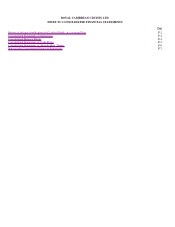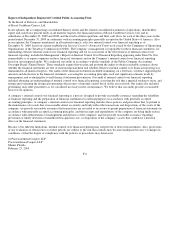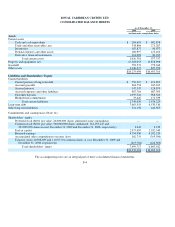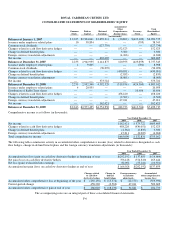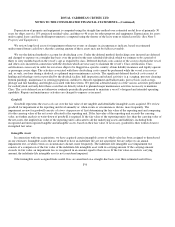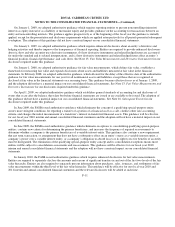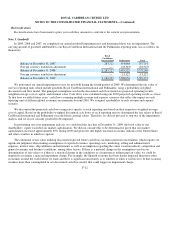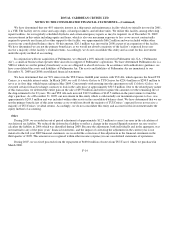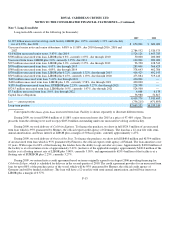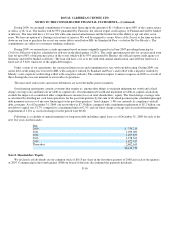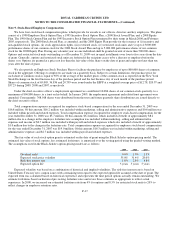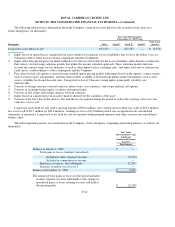Royal Caribbean Cruise Lines 2009 Annual Report Download - page 84
Download and view the complete annual report
Please find page 84 of the 2009 Royal Caribbean Cruise Lines annual report below. You can navigate through the pages in the report by either clicking on the pages listed below, or by using the keyword search tool below to find specific information within the annual report.
ROYAL CARIBBEAN CRUISES LTD.
NOTES TO THE CONSOLIDATED FINANCIAL STATEMENTS—(Continued)
On January 1, 2009, we adopted authoritative guidance which requires reporting entities to present noncontrolling (minority)
interests as equity instead of as a liability or mezzanine equity and provides guidance on the accounting for transactions between an
entity and noncontrolling interests. The guidance applies prospectively as of the beginning of the fiscal year the guidance is initially
applied, except for the presentation and disclosure requirements which are applied retrospectively for all periods presented subsequent
to adoption. The adoption of this guidance did not have a material impact on our consolidated financial statements.
On January 1, 2009, we adopted authoritative guidance which requires enhanced disclosures about an entity’s derivative and
hedging activities and thereby improves the transparency of financial reporting. Entities are required to provide enhanced disclosures
about (a) how and why an entity uses derivative instruments, (b) how derivative instruments and related hedged items are accounted
for under the standard and its related interpretations, and (c) how derivative instruments and related hedged items affect an entity’s
financial position, financial performance, and cash flows. See Note 13. Fair Value Measurements and Derivative Instruments for our
disclosures required under this guidance.
On January 1, 2008, we adopted authoritative guidance for fair value measurements, which defines fair value, establishes a
framework for measuring fair value and expands disclosures about assets and liabilities measured at fair value in the financial
statements. In February 2008, we adopted authoritative guidance, which allowed for the delay of the effective date of the authoritative
guidance for fair value measurements for one year for all nonfinancial assets and liabilities, except those that are recognized or
disclosed at fair value in the financial statements on a recurring basis. This guidance became effective for us as of January 1, 2009,
and the adoption did not have a material impact on our consolidated financial statements. See Note 13. Fair Value Measurements and
D
erivative Instruments for our disclosures required under this guidance.
On April 1, 2009, we adopted authoritative guidance which establishes general standards of accounting for and disclosure of
events that occur after the balance sheet date but before financial statements are issued or are available to be issued. The adoption of
this guidance did not have a material impact on our consolidated financial statements. See Note 16. Subsequent Events for our
disclosures required under this guidance.
In June 2009, the FASB issued authoritative guidance which eliminates the concept of a qualifying special-purpose entity,
creates more stringent conditions for reporting a transfer of a portion of a financial asset as a sale, clarifies other sale-accounting
criteria, and changes the initial measurement of a transferor’s interest in transferred financial assets. This guidance will be effective
for our fiscal year 2010 interim and annual consolidated financial statements and the adoption will not have a material impact on our
consolidated financial statements.
In June 2009, the FASB issued authoritative guidance which eliminates exceptions to consolidating qualifying special-purpose
entities, contains new criteria for determining the primary beneficiary, and increases the frequency of required reassessments to
determine whether a company is the primary beneficiary of a variable interest entity. This guidance also contains a new requirement
that any term, transaction, or arrangement that does not have a substantive effect on an entity’s status as a variable interest entity, a
company’s power over a variable interest entity, or a company’s obligation to absorb losses or its right to receive benefits of an entity
must be disregarded. The elimination of the qualifying special-purpose entity concept and its consolidation exceptions means more
entities will be subject to consolidation assessments and reassessments. This guidance will be effective for our fiscal year 2010
interim and annual consolidated financial statements and the adoption will not have a material impact on our consolidated financial
statements.
In January 2010, the FASB issued authoritative guidance which requires enhanced disclosures for fair value measurements.
Entities are required to separately disclose the amounts and reasons of significant transfers in and out of the first two levels of the fair
value hierarchy. Entities are also required to separately present information about purchases, sales, issuances, and settlements of fair
value measurements within the third level of the fair value hierarchy. This guidance will be effective for our fiscal year 2010 and
2011 interim and annual consolidated financial statements and the relevant disclosures will be added at such time.
F-11


